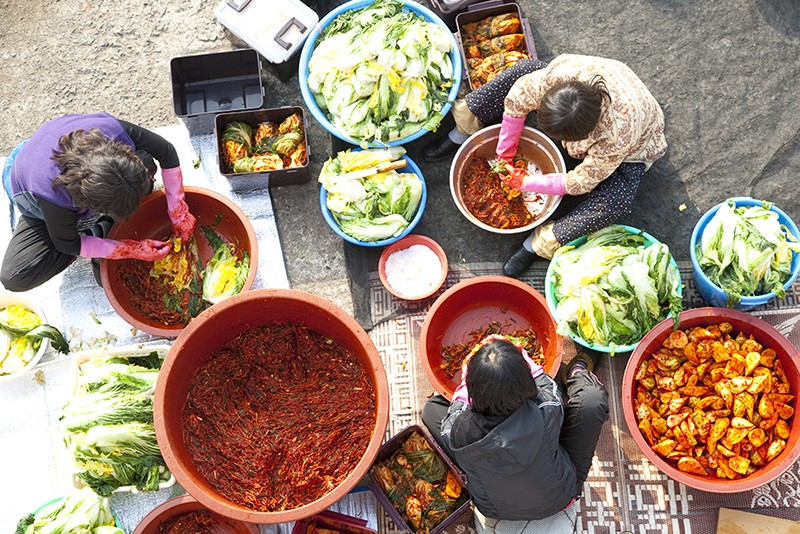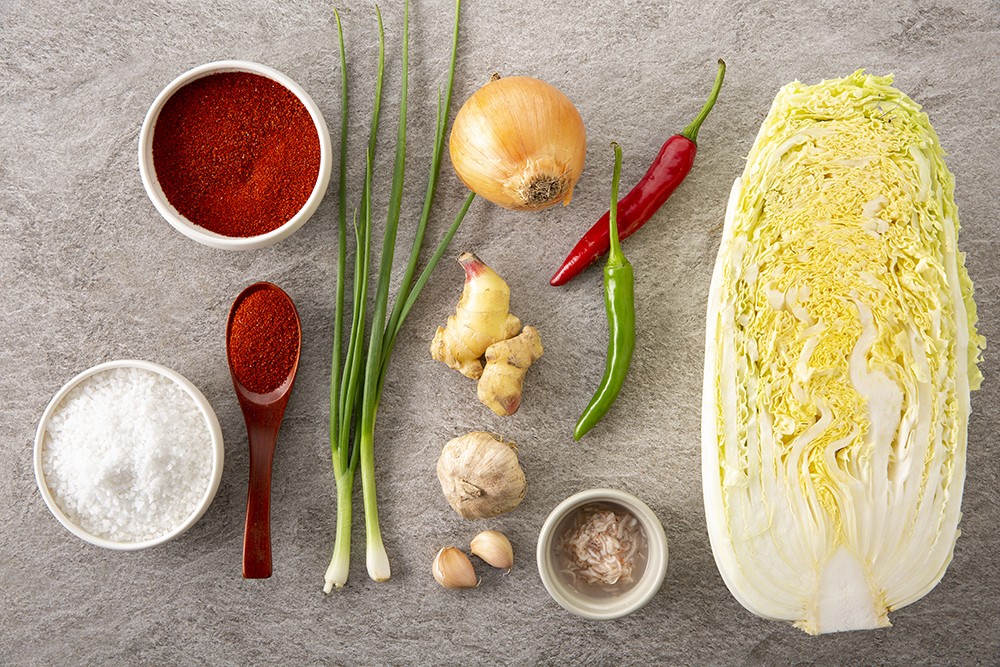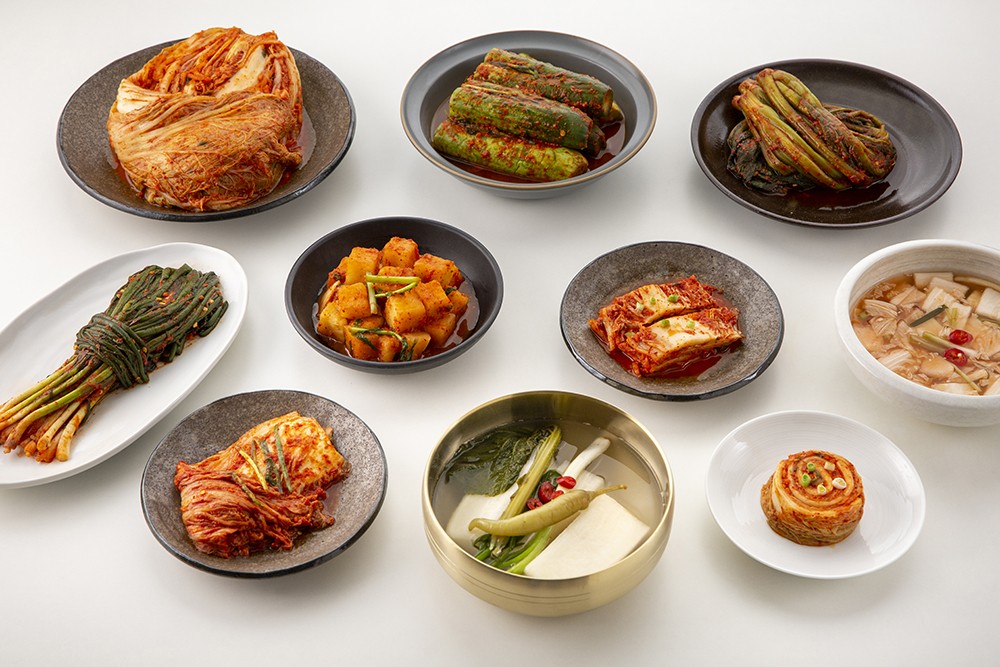한식 읽기 좋은 날
Vol 57. Fermentation and Kimchi
A Labor of Dedication and Waiting: The Fermented Flavors of Kimchi
Fermentation and HANSIK
A key trait of Korean cuisine is the presence of side dishes (banchan), which are served alongside rice and soup. Not all side dishes are equal, however, as evidenced by kimchi, a beloved and possibly the most famous of the Korean banchan. No matter how many side dishes are served, if kimchi is not among them, a meal is bound to feel incomplete. Why is this the case? The answer lies in the history and culture of kimchi, Korea’s most famous fermented food that can only be made with an endless supply of dedication, and the culture of kimjang (kimchi-making).
Article Seo Dongchul (Editorial Team) Sources Hansik Portal, Encyclopedia of Korean Culture, Naver Encyclopedia, Doosan Encyclopedia, K FOOD: Secrets of Korean Cuisine (Design House)

The ancient history of kimchi and fermentation
Fermentation is the process by which a substance is broken down by microorganisms (e.g. mold, yeast, bacteria) to produce a new substance. It is a universal staple of culinary culture that was used to store food for long periods of time, with the most famous examples including cheese, wine, and yoghurt. Korea has a long, storied tradition of fermented food: Koreans are passionate about not only jang (fermented pastes) such as soy sauce, red chili paste, and soybean paste but also kimchi, jeotgal (salted seafood), vinegar, and makgeolli (unrefined rice wine). Of these, kimchi is regarded as the most basic and indispensable side dish that must be a part of every meal.
To stay healthy, humans need to consume vegetables, which are rich in vitamins and minerals. The age-old problem is that vegetables, unlike grains, are very difficult to store. They can theoretically be stored by drying or pickling in salt, but these methods can result in the vegetables losing their flavor or nutritional content. Kimchi fermentation, a technique that has been passed down from one generation to the next for centuries, is the answer that ancient Koreans came up with to, without refrigerators or greenhouses, keep vegetables fresh throughout the long winter.
The most prevailing theory on the history of kimchi Is that it was invented before the Three Kingdoms Period. The reason for this is that the practice of eating salted vegetables existed in Korea since antiquity and, more importantly, the origin of other fermented foods, such as jeotgal and jang, is believed to precede the Three Kingdoms Period.
In ancient times, kimchi most likely looked much more like jangajji, or vegetables (turnips, eggplant, bamboo shoots, etc.) pickled in salt or jang. In the Unified Silla Period and Goryeo dynasty, kimchi started to take on not only the jangajji format but also what we recognize today as watery kimchi (dongchimi and nabakkimchi). In the Goryeo dynasty, the vegetables used for kimchi became more diverse (e.g. cucumber, chives, minari, leaf mustard, bamboo shoots). It is also during this dynasty that kimchi began to be seasoned with ingredients such as green onions and garlic.
Wisdom of storage techniques: Korean-style fermentation
Kimchi began to take on the appearance it is known for today—namely, by being made with peppers, cabbage, and jeotgal—in mid-Joseon. This is when two key ingredients became widely available: peppers entered Korea during the Imjin War (1592-1598), while Napa cabbage began being cultivated in the late 19th century. In other words, the flavors and format that we usually associate with kimchi are only about 100 years old.
The way in which kimchi is fermented is highly unique. An initial salting of the main ingredients (e.g. cabbage, radishes) maintains the crunchiness of the raw vegetables, removes harmful microorganisms, and induces lactic acid fermentation. The “second round” of fermentation is induced by adding jeotgal and spicy seasoning, during which plant-based and animal ingredients ferment together. As a result, kimchi not only satisfies the goal of long-term preservation but is also delicious, fragrant, and gives rise to new nutrients and beneficial substances.


Kimjang, a culture of making and sharing
Kimchi cannot be discussed separately from kimjang, the process by which kimchi is made, which is also a cultural heritage. Kimjang has existed for centuries in Korea and was practiced by virtually every household, to the point that kimjang-created kimchi was referred to as “half of a winter’s food supply.” The practice of pickling vegetables in a way similar to kimchi exists in other cultural spheres, but none have a custom similar to kimjang, which involves the majority of citizens making their own pickled food at the start of winter. Just as families came together for Chuseok and Lunar New Year, people gathered as families or with neighbors when temperatures began to drop significantly to work together and share the outcomes of such labor. Indeed, cooperation and sharing among members of a community was key and continues to be a major element of kimjang. It is why, every winter, many organizations make kimchi to be distributed to the socially-underprivileged.
In 2013, kimjang was registered by UNESCO at the eighth session of the Intangible Cultural Heritage Committee (“Kimjang, Making and Sharing Kimchi”) as an Intangible Cultural Heritage of Humanity for “reaffirming Korean identity” and as “an excellent opportunity for strengthening family cooperation” over many generations. Other unique aspects of kimjang are that, unlike most cultural heritages, all citizens are inheritors of it and the fact that it embodies a lot of diversity: namely, through the variation of kimchi’s ingredients and production methods across regions as well as households.

Over 200 kinds of kimchi
Currently, there are over 200 registered types of kimchi. The largest categorization is by the upper and lower halves of the peninsula: in North Korea, which has a colder climate, kimchi from the Hamgyeong and Pyeongan provinces is mildly-seasoned and very soupy and emphasizes the natural freshness and flavors of the vegetables. Kimchi from the southern half of Korea, on the other hand, is much saltier and spicier due to the hotter climate and is much less soupy.
There are also differences by province. Kimchi in Seoul, the capital of Korea for centuries, was largely modeled on the types eaten by the royal family, while kimchi from Gyeonggi-do is characterized by the use of many ingredients and aesthetically-pleasing shapes. Kimchi from the Chungcheong provinces is mild in taste due to the incorporation of marine produce from the southern regions and vegetables from the northern regions. Kimchi from the Jeolla provinces is very diverse due to the variety of marine produce and involves generous quantities of jeotgal and peppery seasoning. The kimchi of Jeju-do is traditionally mild and focuses on the ingredients’ natural flavors (due to the difficulty of receiving food shipments from the mainland). Jeju kimchi is known for its use of the island’s wealth of marine produce, such as abalone. Kimchi from Gangwon-do is divided into two types: one from the mountainous regions and one from the coastal regions, each of which is made with the ingredients available in its respective region. Kimchi from the Gyeongsang provinces is very hot, spicy, and salty.
One aspect that the kimchi of all provinces has in common is the use of seasonal vegetables from each of Korea’s four distinct seasons for variety. Kimchi made during kimjang season utilized cabbages and radishes (baechu kimchi, baekkimchi, dongchimi, and mu kimchi) and were eaten throughout the long winter months. In the spring, kimchi was made with newly-grown cabbages, minari, mustard leaves, and winter cabbage (eolgari). In the hot summer months, kimchi was made with radish leaves, cucumber, and chives so that it could be consumed immediately before it spoiled. In autumn, tables were graced with chonggak kimchi (whole radish kimchi), eggplant kimchi, and oyster kkakdugi (diced radish kimchi).
Kimchi can also be categorized by how it is made. There is tong kimchi, in which side ingredients are mixed and then applied to the main ingredient (e.g. tong baechu kimchi, chonggak kimchi), and mul kimchi, which literally means “water kimchi” and refers to kimchi in which the main ingredient is consumed with a lot of broth (e.g. dongchimi, nabak kimchi). Kkakdugi is, as implied by its name (based on the Korean word for “to cut into squares”), kimchi made with ingredients such as radishes or cucumbers that are chopped into rectangular pieces and then mixed with seasoning. Sobagi is kimchi in which slices are made in the main ingredient (usually, cucumber or eggplant) with a knife and then filled with seasoning (called so in Korean). There is also bo kimchi (bossam kimchi), which is made by wrapping fruit, seafood, and other ingredients with a wide-leafed vegetable, and seokbakji, a high-end kimchi made by pickling sliced cabbage and radishes and then mixing them with seasoning, oysters, nakji (long-legged octopus), and jogaejeotguk (salted clam).
Any Korean—or someone who is familiar with kimchi—will be salivating by the time they have read this far! For this year’s kimjang season, instead of resorting to store-bought kimchi, how about gathering with your family or neighbors to make your own kimchi?



